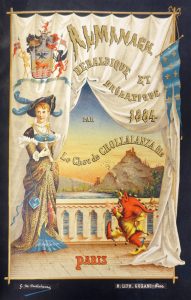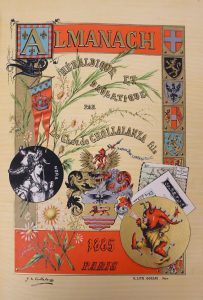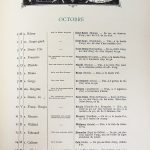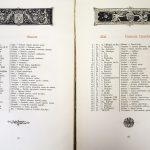

It’s been a wonderfully colorful week here at the Illinois RBML: after Joan Friedman’s illuminating lecture on Owen Jones and color printing on Wednesday, we came across these exquisite chromolithographed title pages from Goffredo di Crollalanza’s series of almanacs: the “Almanach Héraldique et Drôlatique”, from 1883-1885. Almanacs were popular in the 18th and 19th centuries, evolving from practical workaday listings of moon cycles and weather predictions to elaborate calendars including horoscopes, holy days, city directories, and serialized novellas that were designed to draw readers in year after year.
These almanacs are an extreme example of that trend, including not just the highly colored frontispieces above, but a genealogy of the noble houses of Europe, and several different serialized comic adventures following the remarkably named “Baroness Mina de Pfartzhaussentreppe”, pictured on the cover. Although the almanacs are in French, they were published both in Paris and Pisa, and detailed the adventures of a German lady. This pan-European setting emphasizes the high-class sophistication and worldliness these books were meant to emulate for their readers.
The in-text decorations range from the folksy to the futuristic: quaintly romantic country scenes and medieval knights share space with fashion plates and hot air balloons. The calendars in the front of each issue are themed, with 1885 assigning a rustic object like a fruit, bird, color, or animal (and its attendant personality trait) to each day of the year, as Napoleon’s Republican Calendar did in the years before. 1884, on the other hand, assigns each day a town or noble family, complete with heraldic description, associated with that day’s saint.*
It’s easy to see why almanacs were so popular, even ones not as brightly and intricately decorated as these. Unfortunately, as some of you may have noticed, the 1886 volume is considerably smaller, without any of the colored text, much less a frontispiece. The author explains this in his introduction:
Because there are some unfortunate people, you, for example, who weren’t able to procure for themselves the splendid volume of 111,111 pages … the author has asked me to summarize the articles from the large volume and serve them up to you hot off the presses in a volume of reasonable dimensions. Fortified by this authorization, I armed myself with a good pair of scissors and began cutting everything that seemed to me to be superfluous, useless, infantile, boring, flat, sensational, erroneous, immoral, or otherwise pernicious to the health of the reader… and I cut, cut, cut, until I had nothing more than this modest and inoffensive pamphlet… which I have the honor of presenting to you.**
Goffredo di Crollalanza was the son of a successful almanac publisher, but this run petered out after only three years of publication, perhaps due to the prohibitive cost of the beautiful illustrations in the first two volumes. The Illinois RBML is extremely fortunate to have such a complete and beautiful set of items in our Cavagna collection of rare Italian imprints, and we invite you to come explore (and discover your own late-Victorian almanac horoscope!). – KEB
di Crollalanza, Goffredo. Almanach Héraldique et Drôlatique. Paris: E. Plon, Nourrit et c.ie, 1883-1885.
Cavagna 18924
*The author’s birthday makes her an apple tree symbolizing “dangerous beauty” (according to 1885), and a member of the town of Eugenj (according to 1884) with a gold lion crest.
**Any errors in translation are the fault of the author.

